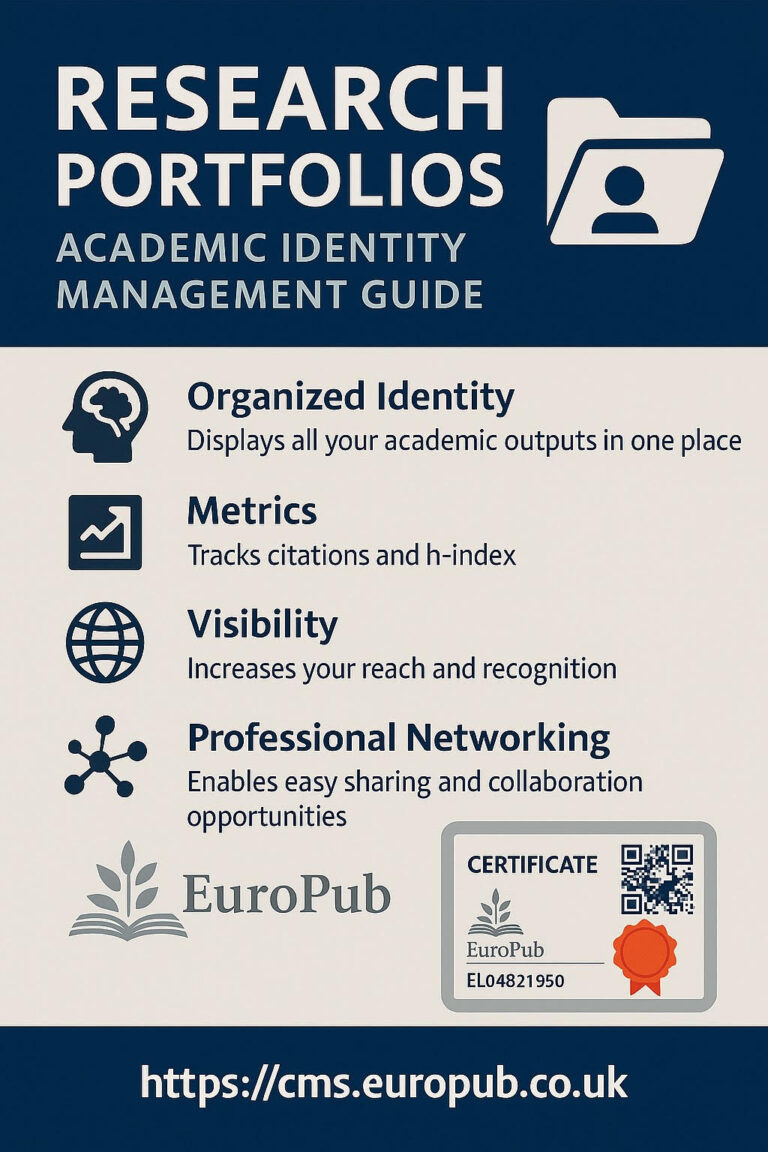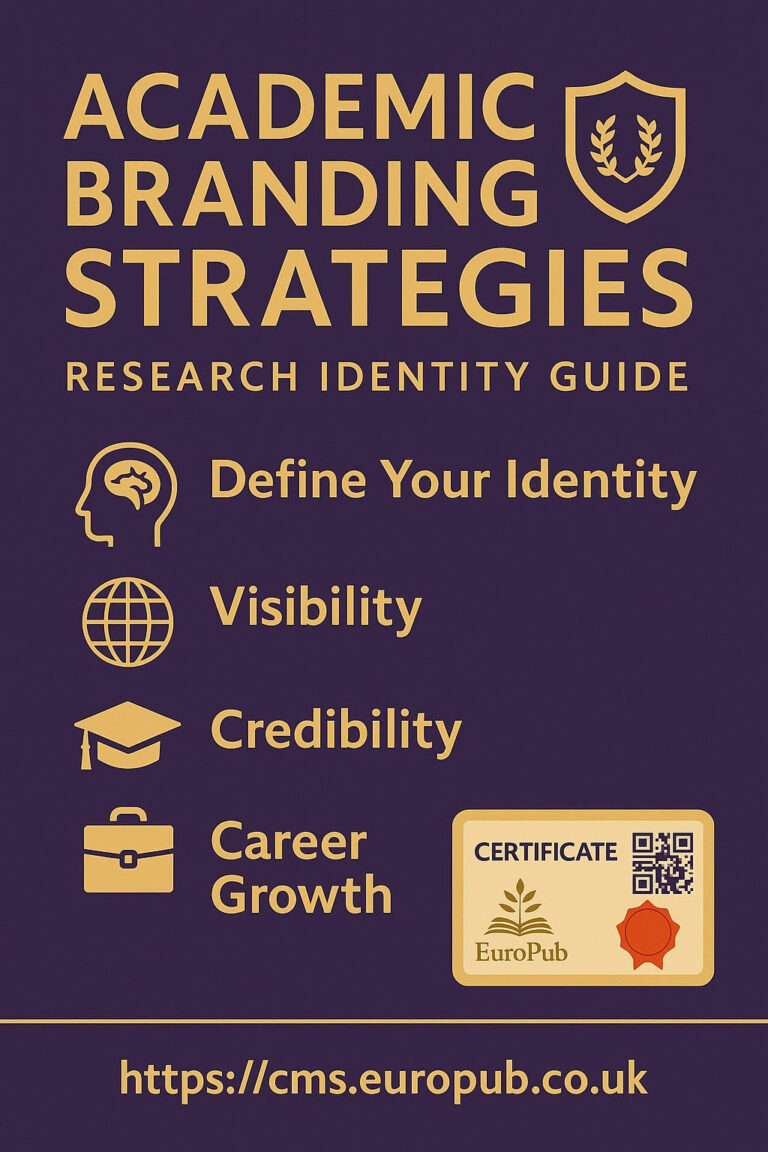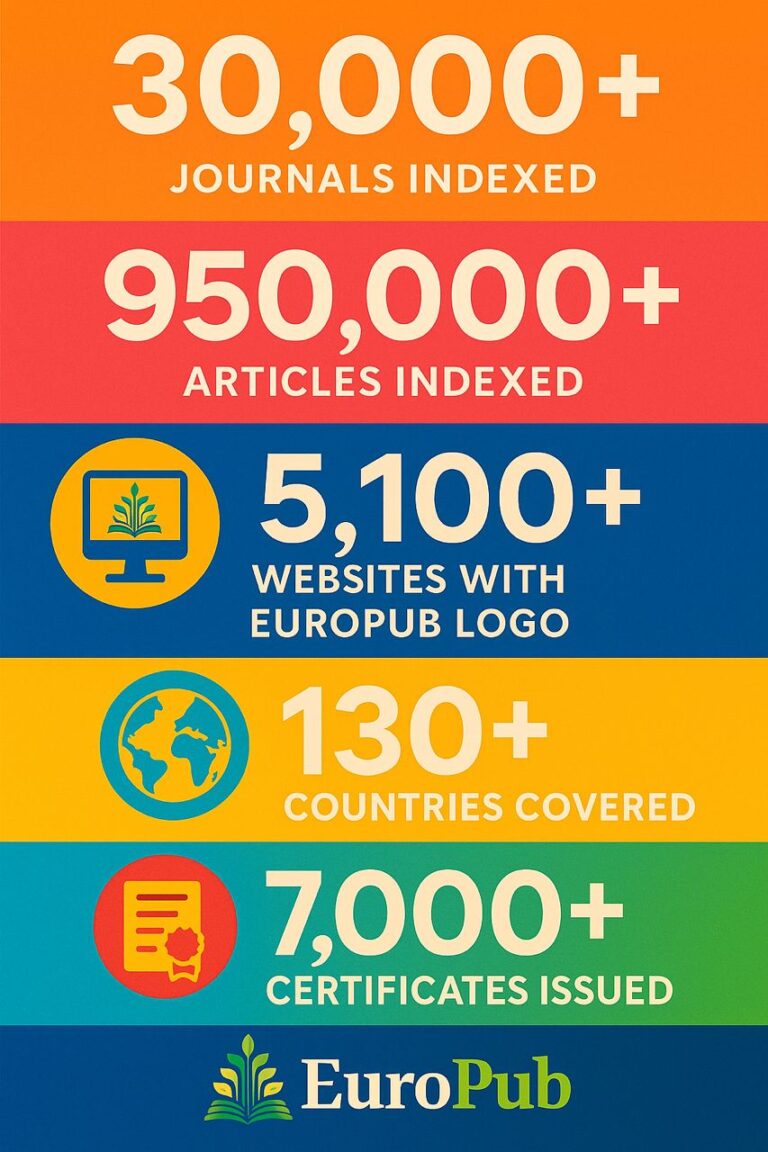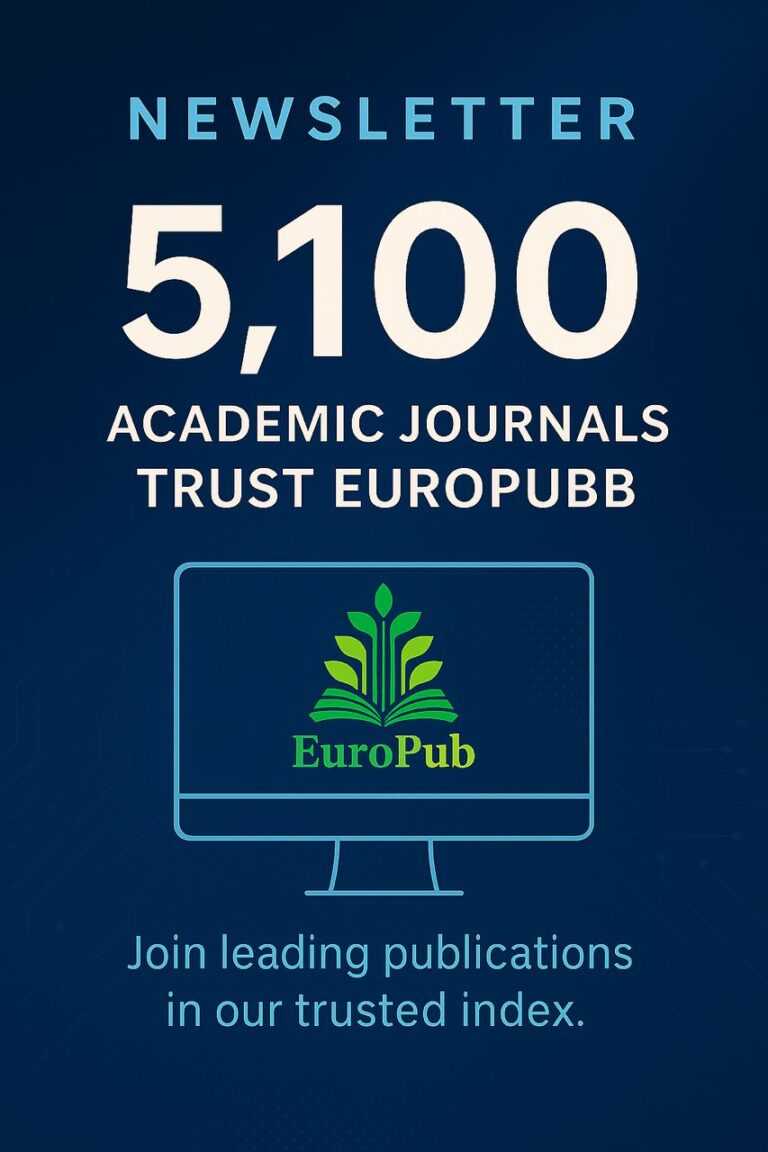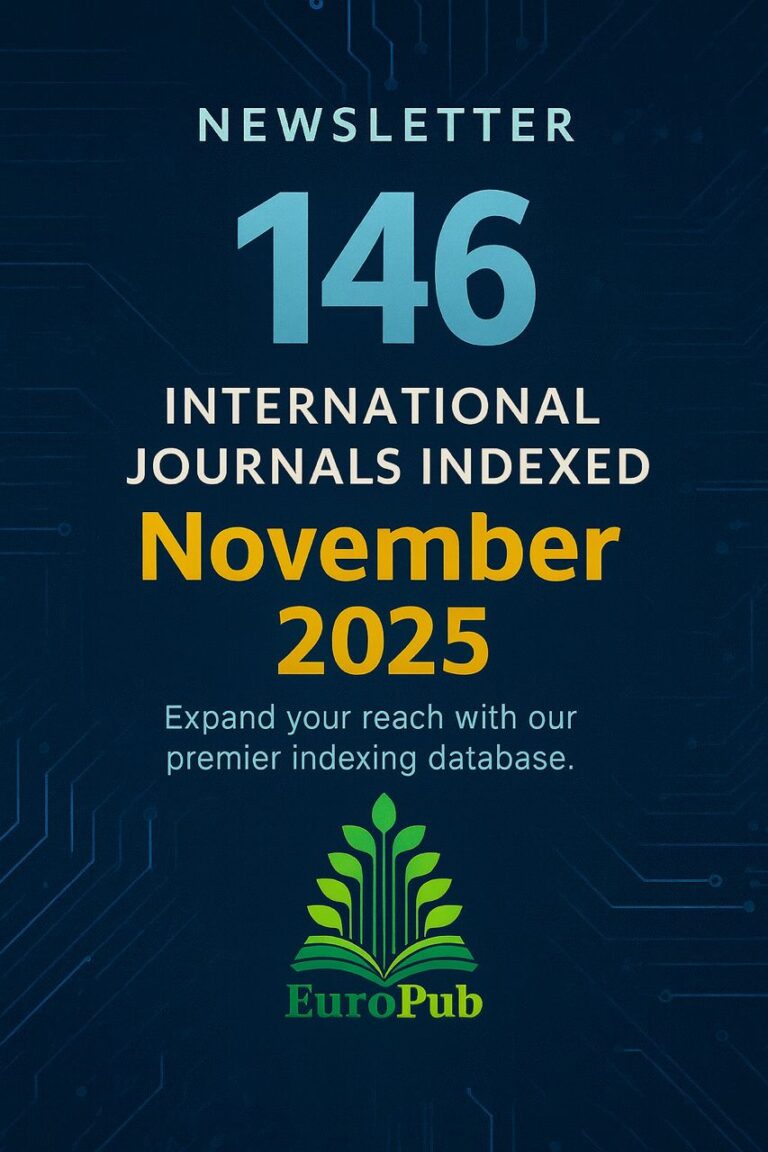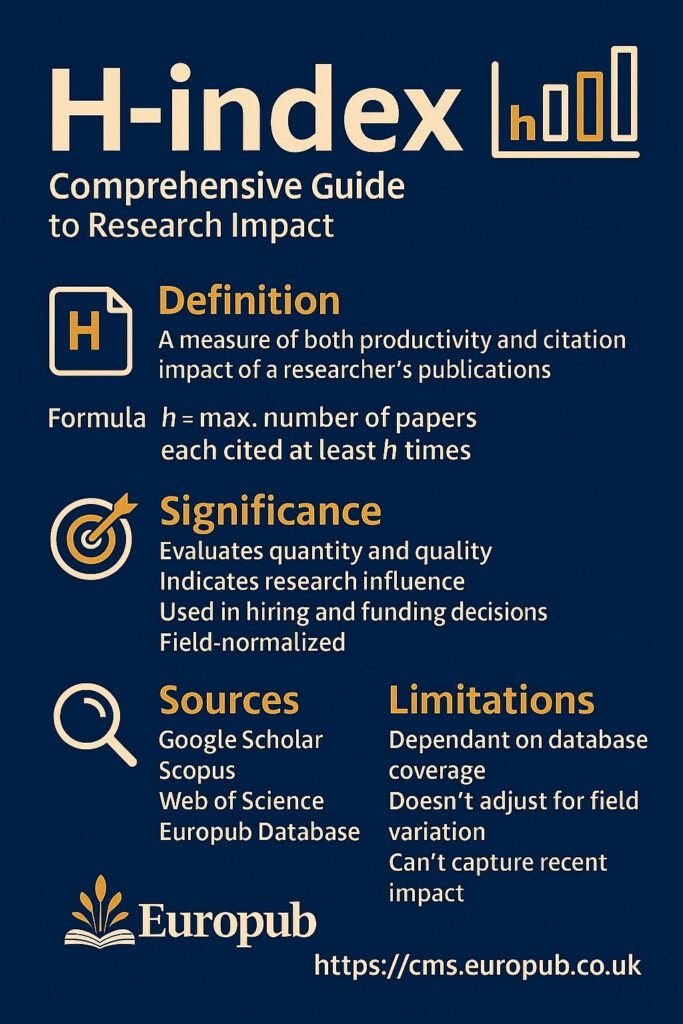
 What Is the H-index?
What Is the H-index?
The H-index (Hirsch index) is a widely used metric that measures both the productivity and citation impact of a researcher’s publications.
It was introduced in 2005 by physicist Jorge E. Hirsch as a way to quantify an individual’s scientific contribution by balancing quantity (number of papers) and quality (citations received).
A scientist has an H-index of h if they have h papers that have each been cited at least h times.
 Example:
Example:
If a researcher has published 20 papers, and 10 of them have been cited at least 10 times each, their H-index = 10.
 Formula
Formula
h = \text{max number of papers with at least } h \text{ citations each.}
Unlike the Impact Factor (which applies to journals), the H-index applies to individual researchers, research groups, or even institutions.
 Why the H-index Matters
Why the H-index Matters
- Evaluates both quantity and quality of research output.
- Used by universities and funding agencies for promotion, tenure, and grants.
- Reflects career-level impact rather than a single paper or year.
- Provides a balanced alternative to total citation counts.
 Where to Find the H-index
Where to Find the H-index
| Platform | Description |
|---|---|
| Google Scholar | Freely available H-index and i10-index under “My Citations.” |
| Scopus (Elsevier) | Provides H-index based on Scopus-indexed papers. |
| Web of Science (Clarivate) | Uses only journals indexed in WoS Core Collection. |
| Europub Database | Displays an integrated H-index estimation combining Europub Impact and citation metrics (https://cms.europub.co.uk). |
 Advantages
Advantages
 Combines productivity and impact.
Combines productivity and impact.
 Resistant to single highly cited papers.
Resistant to single highly cited papers.
 Useful across disciplines.
Useful across disciplines.
 Can be used for individuals, groups, and institutions.
Can be used for individuals, groups, and institutions.
 Limitations
Limitations
 Doesn’t account for authorship order.
Doesn’t account for authorship order.
 Doesn’t adjust for discipline size or citation norms.
Doesn’t adjust for discipline size or citation norms.
 Can’t distinguish self-citations.
Can’t distinguish self-citations.
 Ignores paper age (older researchers may have higher H-index).
Ignores paper age (older researchers may have higher H-index).
 Dependent on database coverage.
Dependent on database coverage.
 Related Metrics
Related Metrics
| Metric | Description |
|---|---|
| G-index | Gives more weight to highly cited papers. |
| i10-index | Number of papers cited at least 10 times (Google Scholar). |
| m-index | Adjusts H-index by years since first publication (career-normalized). |
| h5-index | Google Scholar’s H-index for the last 5 years. |
 Interpreting the H-index
Interpreting the H-index
| Field | Average H-index (Mid-career) |
|---|---|
| Physics / Chemistry | 20–40 |
| Life Sciences | 25–50 |
| Engineering | 15–30 |
| Social Sciences | 10–25 |
| Humanities | 5–15 |
Always compare H-index within the same field to ensure fairness.
 FAQs (Frequently Asked Questions)
FAQs (Frequently Asked Questions)
Q1. Who created the H-index?
 Jorge E. Hirsch, physicist at the University of California, San Diego (2005).
Jorge E. Hirsch, physicist at the University of California, San Diego (2005).
Q2. How can I find my H-index?
 Check your profile on Google Scholar, Scopus, or Web of Science.
Check your profile on Google Scholar, Scopus, or Web of Science.
Q3. Why does my H-index differ across databases?
 Because each database includes a different set of journals and citations.
Because each database includes a different set of journals and citations.
Q4. Can I calculate my H-index manually?
 Yes — sort your publications by citation count and find the point where the paper number equals or exceeds its citation count.
Yes — sort your publications by citation count and find the point where the paper number equals or exceeds its citation count.
Q5. Does H-index include self-citations?
 Some databases (like Scopus) can exclude them; Google Scholar includes them by default.
Some databases (like Scopus) can exclude them; Google Scholar includes them by default.
Q6. Is H-index a lifetime metric?
 Yes — it typically increases over time as a researcher’s papers accumulate citations.
Yes — it typically increases over time as a researcher’s papers accumulate citations.
Q7. Can H-index decrease?
 No — it can only remain the same or increase (unless citations are retracted).
No — it can only remain the same or increase (unless citations are retracted).
Q8. What is a good H-index?
 It depends on field and career stage.
It depends on field and career stage.
Early-career: 3–8 | Mid-career: 10–20 | Senior: 20–40+
Q9. How to improve H-index ethically?
 Publish consistently.
Publish consistently.
 Collaborate internationally.
Collaborate internationally.
 Cite relevant, high-quality literature.
Cite relevant, high-quality literature.
 Share open-access versions to boost discoverability.
Share open-access versions to boost discoverability.
 Present at conferences and promote your work online.
Present at conferences and promote your work online.
Q10. Can journals have an H-index?
 Yes — journal-level H-index exists (based on all papers published).
Yes — journal-level H-index exists (based on all papers published).
Q11. How does H-index compare to Impact Factor?
 IF measures journal influence, H-index measures author impact.
IF measures journal influence, H-index measures author impact.
Q12. Are there mobile apps for tracking H-index?
 Yes — Google Scholar app, Publish or Perish, and Scopus Author Preview tools.
Yes — Google Scholar app, Publish or Perish, and Scopus Author Preview tools.
Q13. What is the m-index?
 H-index divided by the number of years since the researcher’s first publication — used to normalize across career lengths.
H-index divided by the number of years since the researcher’s first publication — used to normalize across career lengths.
Q14. How to check institutional H-index?
 On Scopus Institution Profiles or Web of Science Organization Search.
On Scopus Institution Profiles or Web of Science Organization Search.
Q15. What is Europub’s H-index metric?
 Europub integrates an author H-index derived from the EuroCode system — connected to verified certificates and research profiles via
Europub integrates an author H-index derived from the EuroCode system — connected to verified certificates and research profiles via
 Useful Tools & Links
Useful Tools & Links
- Google Scholar Citations
- Scopus Author Preview
- Web of Science Author Search
- Europub Certificates & Metrics
- Publish or Perish Software
 Summary
Summary
| Category | Description |
|---|---|
| Full Name | Hirsch Index |
| Purpose | Evaluate researcher productivity & impact |
| Main Use | Academic promotion, funding, visibility |
| Calculation Source | Citations per publication |
| Main Databases | Google Scholar, Scopus, Web of Science |
| Ethical Note | Avoid citation manipulation or coercive citations |
